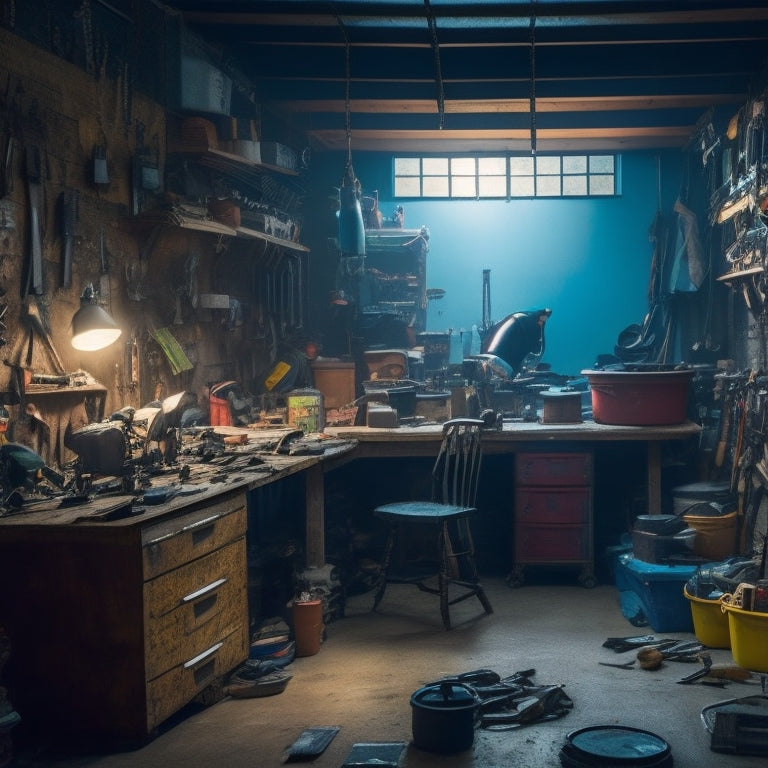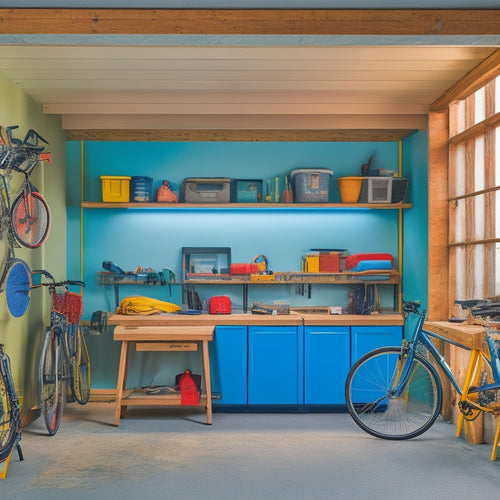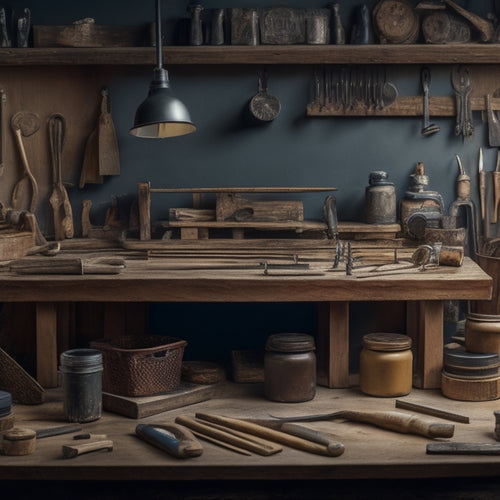
Why Can't Hobbyists Afford Wasted Space Anymore?
Share
You're operating on a shoestring budget, and every square inch of your workspace counts. With Rising costs and shrinking spaces, wasted space is a luxury you can't afford. Maximizing vertical storage, strategic tool placement, and efficient workbench design can make all the difference. By decluttering and implementing smart shelving systems, you'll boost productivity and reduce frustration. You've got to streamline your workflow and make every inch count. Now, it's time to take your space optimization to the next level and uncover the secrets to a more efficient, cost-effective workspace.
Key Takeaways
• Hobbyists often work in small, cramped spaces, making every inch count for efficient workflow and productivity.
• Wasted space can lead to clutter, disorganization, and lost time, hindering hobbyists' ability to complete projects efficiently.
• Maximizing vertical storage space and utilizing shelves, hooks, and storage units can help reclaim valuable floor space for work.
• Efficient tool placement strategies, such as grouping similar tools together, can reduce fatigue and increase productivity in cramped spaces.
• Decluttering and optimizing workbench design can help hobbyists stay focused, avoid frustration, and make the most of their limited space.
Maximizing Vertical Storage Space
To optimize your workshop or studio's storage capacity, make the most of your ceiling height by installing shelves, hooks, or storage units that capitalize on vertical space. By doing so, you'll access valuable floor space, reducing clutter and increasing productivity. This is especially vital for hobbyists who often work with limited square footage. Implementing space-saving hacks and innovative solutions will help you stay organized and focused on your projects.
Effective vertical organization is key to maximizing storage capacity. Consider installing wall-mounted shelves, bins, or baskets to store infrequently used items, keeping them out of the way yet still accessible.
You can also utilize storage units with adjustable shelves to accommodate items of varying sizes. Proper storage techniques will prevent damage to your supplies and equipment, ensuring they remain in good condition.
Optimal Tool Placement Strategies
By strategically positioning your tools, you can shave precious minutes off your project timelines and reduce frustration. Effective tool organization is key to maximizing space utilization in your workshop.
Start by grouping similar tools together, such as all your hand tools or power tools. This will save you time searching for the right tool and prevent clutter from building up.
Next, consider the frequency of use for each tool. Place your most frequently used tools in easy-to-reach locations, while less frequently used tools can be stored in harder-to-reach areas or on higher shelves. This will help you work more efficiently and reduce fatigue.
Additionally, designate specific areas for specific tasks, such as a designated area for sanding or drilling. This will help keep your workspace organized and prevent tools from getting mixed up or lost.
Efficient Workbench Design Ideas
You can greatly enhance your workshop's productivity by designing a workbench that streamlines your workflow and accommodates your most frequently used tools and tasks. An ergonomic layout is key to achieving this goal. Consider the height and position of your work surface, ensuring it allows you to work comfortably without straining your back or neck.
Next, think about the placement of your tools and materials. A modular organization system can help keep your workspace tidy and organized, making it easier to access what you need when you need it. Incorporate storage bins, trays, and hooks to keep items off the floor and out of the way. This will also help reduce clutter and prevent lost or misplaced items.
Decluttering for Better Productivity
Cluttered workspaces silently sabotage productivity, impeding your ability to focus and efficiently complete tasks. As a hobbyist, you can't afford to waste time searching for lost tools or supplies amidst the chaos. Decluttering your workspace is essential for better productivity.
Here are some decluttering tips to help you achieve a minimalist workspace:
| Tip | How It Helps | Benefits |
|---|---|---|
| Sort and categorize tools | Easy access to what you need | Saves time, reduces frustration |
| Designate a home for each item | Keeps workspace organized | Reduces visual clutter, improves focus |
| Purge unnecessary items | Removes distractions, frees up space | Boosts productivity, reduces stress |
Smart Shelving and Racking Systems
How do smart shelving and racking systems optimize your workspace, ensuring that every tool and supply is within easy reach? By implementing these space-saving solutions, you can transform your hobby space into a well-oiled machine, where everything has its designated place. This, in turn, boosts your productivity and reduces frustration.
Here are three ways smart shelving and racking systems can benefit your workspace:
-
Maximize Vertical Space: Make the most of your ceiling height by installing wall-mounted shelves and racks, keeping frequently used items within easy reach while keeping less-used items stored away.
-
Customizable Configurations: Choose from a variety of DIY storage solutions that can be tailored to your specific needs, ensuring that every tool and supply has a designated spot.
-
Easy Accessibility: Label and categorize your shelves and racks, making it easy to find what you need when you need it, saving you time and energy.
Compact Corner Workshop Solutions
Optimizing corner spaces with compact workshop solutions enables hobbyists to reclaim valuable real estate in their work area, creating a more efficient and productive environment.
By maximizing these often-wasted areas, you can fit more tools, supplies, and materials within arm's reach, reducing clutter and increasing your overall workflow.
Corner storage solutions, such as rotating carousels, slide-out bins, and foldable shelves, are designed to make the most of these tight spaces. These space-saving solutions allow you to store items like paints, adhesives, and small parts in an organized and accessible manner.
By incorporating compact corner workshop solutions, you'll be able to quickly locate the tools you need, reducing downtime and increasing your productivity.
Additionally, these solutions can be customized to fit your specific needs, ensuring that your workspace is tailored to your unique requirements.
Creative Use of Ceiling Space
By harnessing the often-underutilized expanse above your workstation, you can access a wealth of storage possibilities, freeing up valuable floor and surface space for more pressing needs. This creative use of ceiling space not only optimizes your workshop's layout but also adds an aesthetic touch.
Here are three ways to make the most of your ceiling space:
-
Hanging Planters and Decorative Lighting: Suspend planters filled with greenery or flowers to bring in a touch of nature, or install decorative lighting to create ambiance. This adds visual interest and creates a welcoming atmosphere.
-
Suspended Artwork: Showcase your artistic side by hanging your creations or inspirational pieces from the ceiling. This not only saves wall space but also adds a unique dimension to your workshop.
-
Overhead Organization: Utilize ceiling-mounted shelves, baskets, or hooks to store items like tools, supplies, or materials. This keeps your workspace clutter-free and makes it easier to access what you need.
Streamlining Workflow With Zones
Streamlining Workflow With Zones
Dividing your workshop into distinct zones allows you to establish a logical workflow, resulting in increased productivity and reduced frustration. By designating specific areas for different tasks, you can optimize your space utilization and organization zones. This approach helps you stay focused on the task at hand, reducing the time spent shifting between activities.
Here's a breakdown of how you can allocate your workspace:
| Zone | Task | Benefits |
|---|---|---|
| Design Zone | Planning, designing | Enhanced creativity, reduced errors |
| Fabrication Zone | Building, assembling | Increased workflow efficiency, reduced clutter |
| Assembly Zone | Final assembly, quality control | Improved precision, reduced rework |
| Storage Zone | Tool and material storage | Easy access, reduced waste |
| Break Zone | Rest, relaxation | Improved mental clarity, reduced fatigue |
Frequently Asked Questions
Can I Repurpose Old Furniture for Workshop Storage?
You can breathe new life into old furniture by upcycling it for workshop storage, finding creative solutions to maximize space and reduce waste, and giving your workshop a unique, eco-friendly vibe.
How Do I Deal With Messy Workshop Electrical Cords?
"Tame the electrical cord beast by implementing cord organization and cable management strategies, such as labeling, bundling, and securing cords with zip ties or cord organizers, to create a safe and efficient workshop environment."
Are There Any Affordable Smart Workshop Lighting Options?
You can upgrade your workshop lighting with energy-efficient LEDs and budget-friendly solutions. Consider DIY lighting upgrades that integrate smart technology, such as motion sensors and timers, to optimize your workshop's lighting needs.
Can I Convert a Small Closet Into a Workshop?
"As you stumble upon that hidden closet, you realize it's the perfect spot for a workshop. You'll need to optimize the space, but with clever closet conversion techniques, you can create a functional workshop that's tailored to your needs."
How Do I Prevent Rust in My Workshop Tools and Equipment?
You'll prevent rust in your workshop tools and equipment by implementing rust prevention techniques, practicing regular tool maintenance, and utilizing effective storage solutions that promote organized workshop organization, ensuring your tools stay rust-free and ready for use.
Related Posts
-

7 Essential Foldable Workbenches for Garages
When selecting a foldable workbench for your garage, you'll want to contemplate factors such as space-saving design, ...
-

Top 5 Small Tool Organizers for Your Workshop
You're looking to optimize your workshop's efficiency with high-quality small tool organizers. Compact storage soluti...
-

Best Materials for Garage Wall-Mounted Cabinets
When selecting materials for your garage wall-mounted cabinets, you'll want to evaluate options that balance durabili...


